Open and Accurate Air Quality Monitors
We design professional, accurate and long-lasting air quality monitors that are open-source and open-hardware so that you have full control on how you want to use the monitor.
Learn Moreby Achim Haug on November 14, 2024
We hear comparisons a lot.
How does AirGradient compare to Airthings ?
How about PurpleAir ?
There are many more we could list, and we hear these every day. This is a natural question for any customer who is wondering what product to buy because no one wants to buy a bad product!
We encourage these comparisons and for customers to look at all the options on the market; that is why we have written comparison articles for both of these other brands in the past.
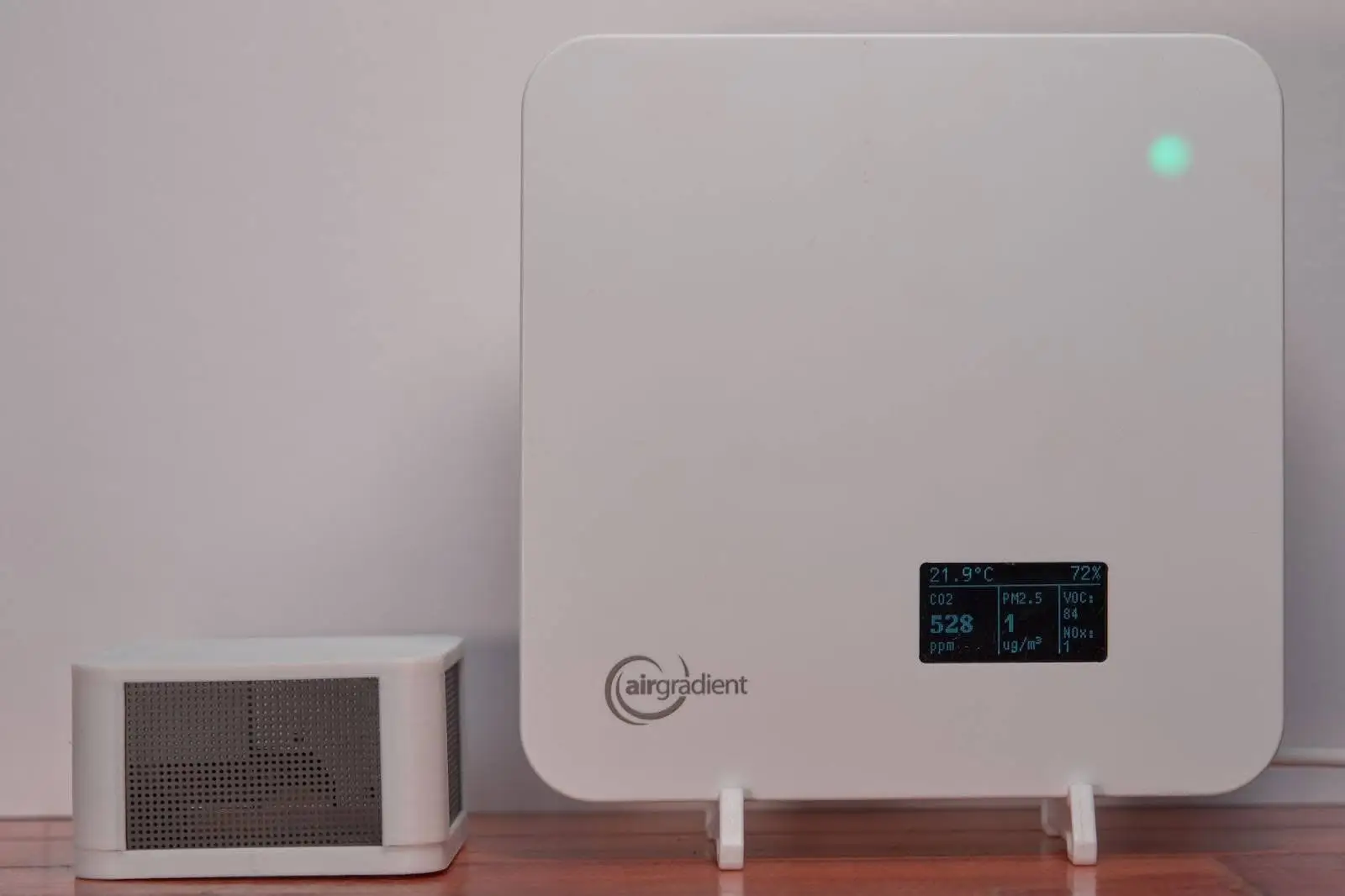
However, when it comes to direct comparisons, there is one monitor we hear about above all else - the Apollo AIR-1. This is the most common comparison we see because Apollo shares many of our values with its air quality monitor. Namely, it supports open-source software, allows for data ownership, and even allows entirely local operations. These similarities naturally cause customers to draw comparisons between our monitors.
In today’s article, we want to take a look at the Apollo AIR-1 and highlight its strengths and weaknesses compared to the AirGradient ONE so users can make an informed purchasing decision.
We will do our best to remain unbiased through this article. Still, we are comparing a monitor to our own, so we recommend reading other comparisons from third-party sources before purchasing either monitor.
We also want to highlight that we admire what Apollo is doing with its AIR-1, which provides very affordable and open-source air quality monitoring to many.
| Configuration | Sensors | Price |
|---|---|---|
| Apollo AIR-1 (Base Model) | SEN55 | $89.99 |
| Apollo AIR-1 (Mid Model) | SEN55, SCD41 | $108.99 |
| Apollo AIR-1 (High Model) | SEN55, SCD41, MiCS-4514 | $149.99 |
| AirGradient ONE (Kit) | PMS5003, SGP40, S8, SHT40 | $138 |
| AirGradient ONE (Pre-Assembled) | PMS5003, SGP40, S8, SHT40 | $195 |
The Apollo AIR-1 monitor is available in several configurations at different price points. The most basic model, which costs just under $90, offers a SEN55 sensor that monitors PM, VOCs, NOx, temperature, and relative humidity.
The next ‘tier’ monitor offers the SEN55 with a Sensirion SCD41 CO2 sensor. This photoacoustic NDIR sensor increases the device’s price to $108.99. We think this is the most compelling variant because CO2 concentration is an important metric to measure on an indoor air quality monitor, and we don’t think the third configuration is worth the extra cost - more on that soon.
Finally, a third model offers a MiCS-4514 gas sensor alongside the SEN55 and SCD41. This monitor costs almost $150, but we don’t believe you should opt for this option for reasons we will discuss soon.
It is also possible to purchase the AIR-1 with the SEN55 and MiCS sensor (without an SCD41), but we don’t recommend this configuration either.
On the other hand, the AirGradient ONE comes in only one configuration but is available as either a DIY kit or a pre-assembled monitor. The Apollo AIR-1 with the added CO2 sensor measures the same pollutants as the AirGradient ONE, again making these devices comparable.
The AirGradient ONE (DIY) is $138, while the fully assembled monitor is $195. This makes it significantly more expensive than the Apollo monitors (in all configurations), but it also comes with a test certificate from our lab and is CE, RoHS, REACH, and RESET certified - none of which the Apollo AIR-1 has.
Between these two monitors in their different variations, prospective customers have a wide range of choices and can find a monitor that suits their wants and needs. Both the Apollo AIR-1 base model and mid-range model offer fantastic value for the money.
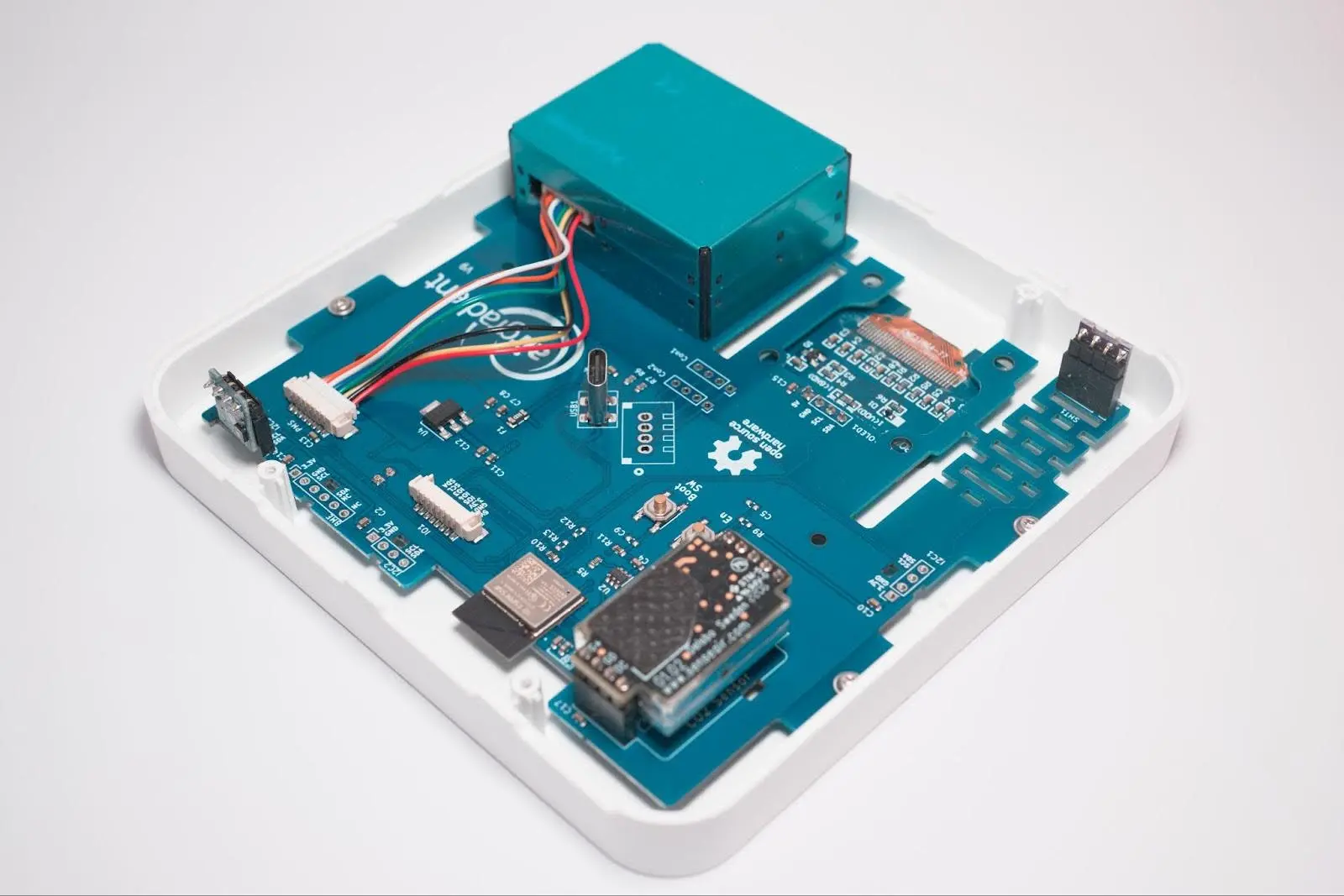
While the AirGradient ONE and Apollo AIR-1 both monitor the same pollutants, they use very different sensors to do so. Below is a table of the sensors used in each monitor and the pollutants they measure.
| Configuration | Sensors | Price |
|---|---|---|
| Apollo AIR-1 (Base Model) | Sensirion SEN55 (PM, VOCs, NOx, temperature, relative humidity) | $89.99 |
| Apollo AIR-1 (Mid Model) | Sensirion SEN55 (PM, VOCs, NOx, temperature, relative humidity), SCD41 (CO2) | $108.99 |
| Apollo AIR-1 (High Model) | Sensirion SEN55 (PM, VOCs, NOx, temperature, relative humidity), SCD41 (CO2), MiCS-4514 (gases) | $149.99 |
| AirGradient ONE (Kit) | Plantower PMS5003 (PM), Sensirion SGP40 (VOCs & NOx), Senseair S8 (CO2), Sensirion SHT40 (temp & RH) | $138 |
| AirGradient ONE (Pre-Assembled) | Plantower PMS5003 (PM), Sensirion SGP40 (VOCs & NOx), Senseair S8 (CO2), Sensirion SHT40 (temp & RH) | $195 |
With the same sensors (with the exception of the MiCS-4514), both monitors are great for indoor air quality monitoring and don’t make any trades or compromises in regard to sensor arrangement. The sensors (again, with the exception of the MiCS-4514) are from well-known and reputable manufacturers, and ample research has been carried out with them.
Both the AirGradient and Apollo devices use PM and CO2 sensors from reputable brands. In the case of AirGradient, we use the Plantower PMS5003 for PM and the Senseair S8 for CO2. Apollo instead opts to use Sensirion sensors for both PM and CO2, the SEN55 for PM and the SCD41 for CO2.
Beginning with particulate matter, both sensors are commonly used in air quality monitors but the PMS5003 has appeared in more studies due to it being on the market for longer. The PMS5003 is generally considered to be accurate, but it does overreport particle concentrations (especially in the case of smoke), which is why the EPA developed an algorithm to improve the accuracy of these sensors for its AirNow map. We allow users to apply the EPA correction on their dashboard for better accuracy.
Below is a graph comparing the readings from the two monitors (in one-hour intervals) with no corrections applied.
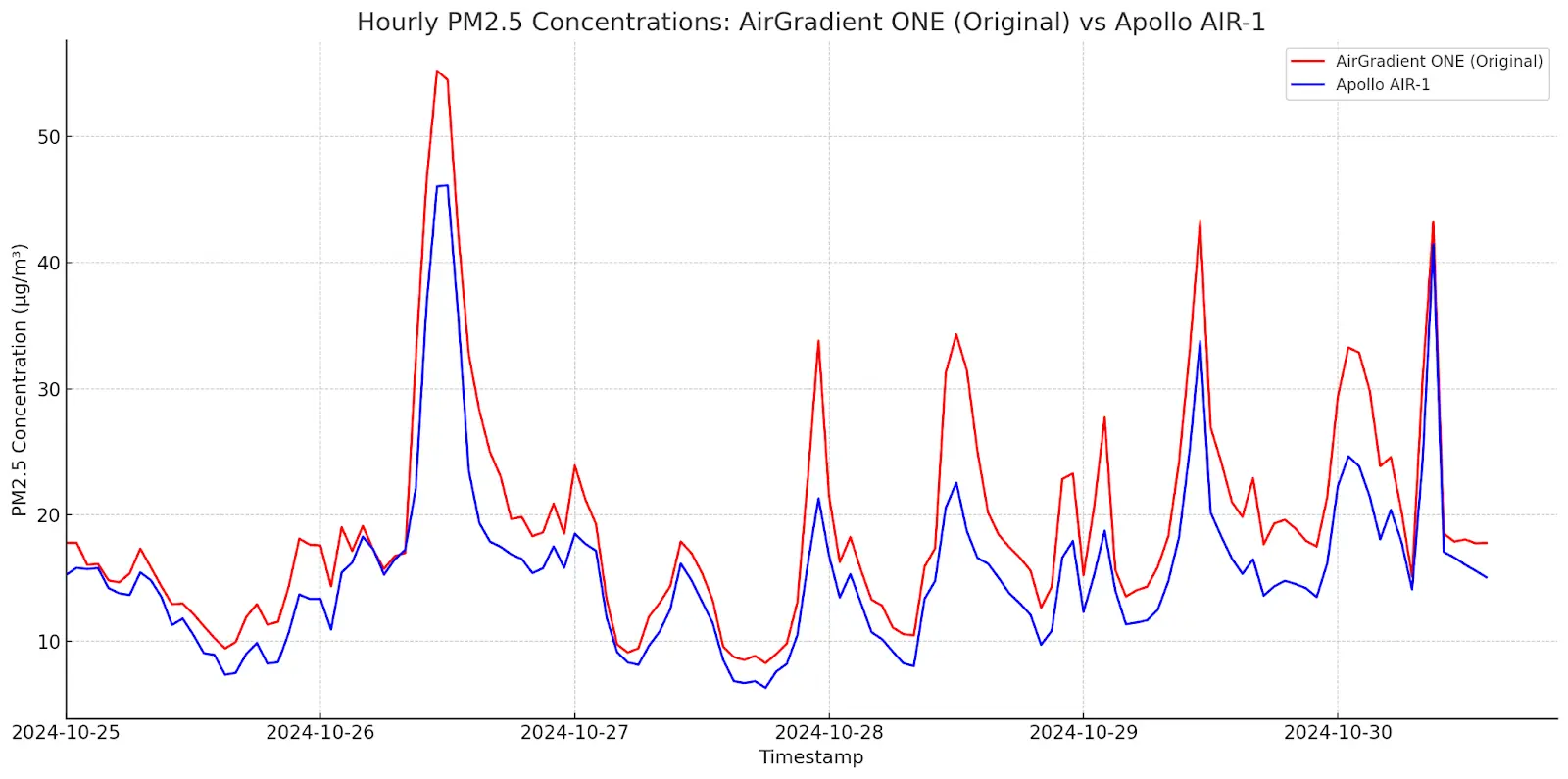
Below is another graph over the same time period, but with the EPA correction applied to the AirGradient data. As you can see, it impacts the data significantly, but both monitors show very similar trends and are within their manufacturer-specified stated accuracies. Both also consistently follow the same trends and perform well.
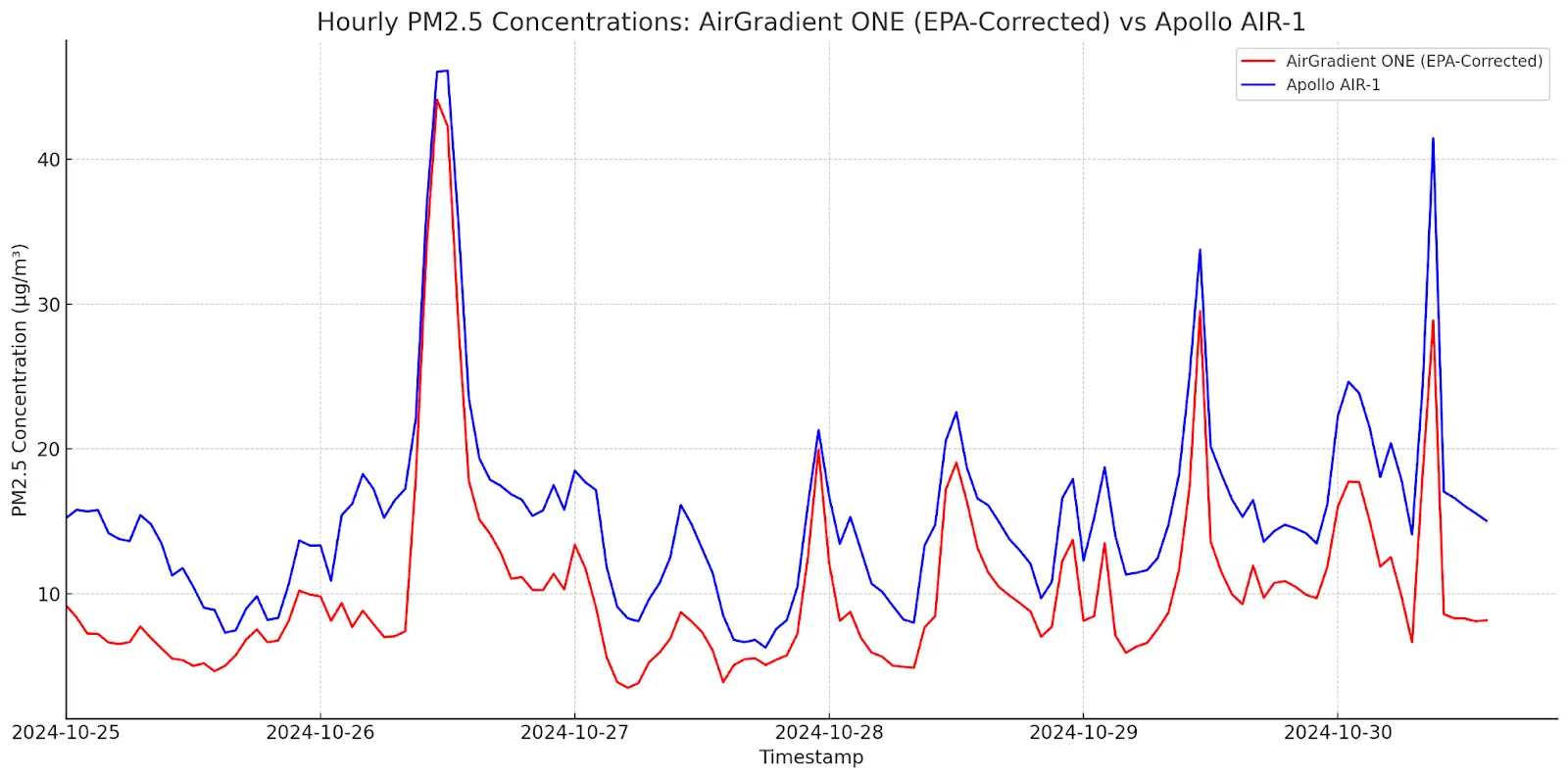
When it comes to carbon dioxide, we see very similar results from both monitors, highlighting the accuracy of the sensors in both monitors. While the monitors use different sensing technologies (transmissive NDIR compared to photoacoustic NDIR), both provide similar results and are accurate. With that said, the Apollo AIR-1 features an air pressure sensor that feeds data to the carbon dioxide sensor, making it more accurate at higher altitudes. While this won’t impact most people, it does make it a better choice for those living at high altitudes.
We will soon be upgrading from the SenseAir S8 to the S88, and this sensor features pressure compensation. However, even once we’ve implemented this change, the user will have to manually feed the information to the sensor, as we don’t include a pressure sensor to automatically account for this.
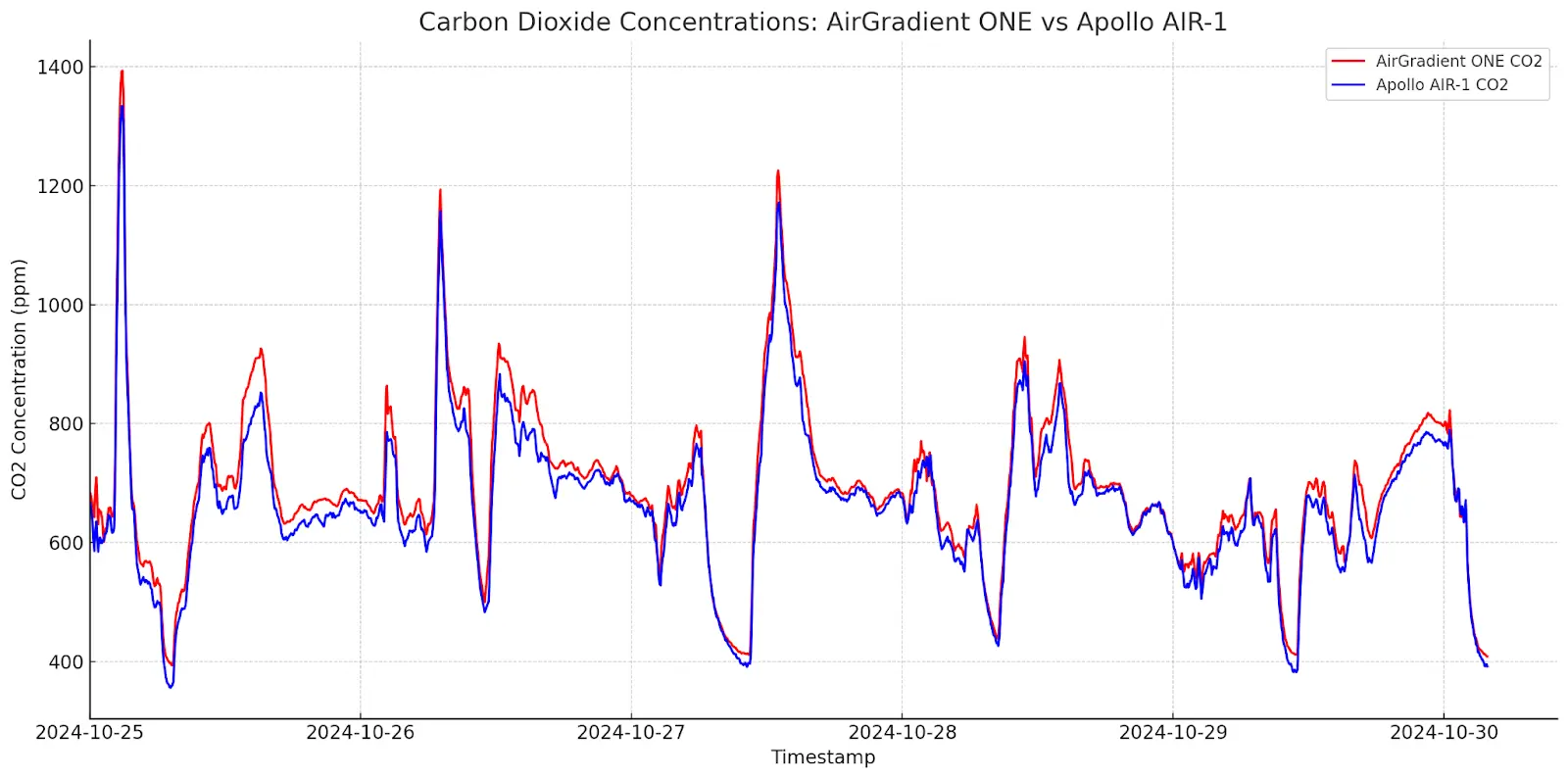
When it comes to VOCs, both monitors use Sensirion sensors, which show VOCs on a relative index. This makes them great for identifying trends in VOC concentrations (increasing, decreasing, or steady levels), but means that they can’t show absolute concentrations and are, therefore, difficult to compare. With that said, AirGradient natively supports allowing the user to set different learning periods (from 12 hours to 30 days). Apollo does not currently support this feature, meaning the AirGradient ONE is better at identifying longer-term VOC trends.
When it comes to temperature and relative humidity, the Apollo AIR-1 is also less accurate as its small size means it generates a lot of internal heat. While this can be offset through Home Assistant, you will need a monitor to compare to to know if these readings are accurate, as the default offset applied by Apollo appears to be too low from our testing. That said, this isn’t a big issue since it can be accounted for.
Overall, with these sensor configurations we think you can’t go wrong with either monitor. Both have advantages and disadvantages, but the most important aspect is that you, as the customer, have a choice between two great monitors that have different strengths.
Overall, we appreciate the quality and accuracy of the sensors used inside the Apollo AIR-1. However, there is one caveat: the MiCS-4514, the gas sensor used in the high-end configuration of the AIR-1.
Both studies and users have found that this gas sensor exhibits problems such as cross-sensitivity (having the measurements of one gas reading be influenced by other gasses), low-sensitivity (not reacting to lower concentrations and smaller changes in concentrations) and can spike when no gas is present. This is also not a certified sensor, so it should not be used in place of a fire alarm or other emergency devices.
SGX, the manufacturer of the sensor provides the below graph in its documentation of the sensor. Since this is a metal oxide sensor (MOS), it uses increasing resistance to identify gas concentrations. However, as per their own documentation, a resistance of 0.5 could be around 0.5 ppm of hydrogen sulfide, 1.1 ppm of ammonia, 1.25 ppm of ethanol, 8 ppm of carbon monoxide, or 6000 ppm of methane.
This causes an issue because the sensor can’t differentiate between these gases. This resistance could be harmless (ammonia, ethanol, and even hydrogen sulfide are not dangerous at such low concentrations - especially for short-term exposures) or require immediate attention (methane levels this high aren’t toxic, but they can indicate a build-up that needs ventilation immediately).
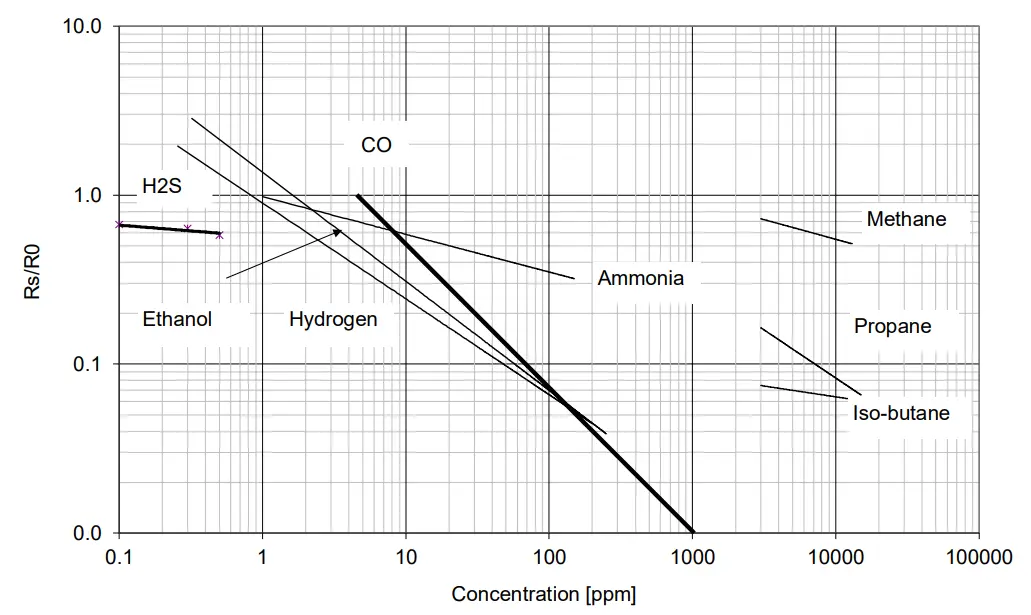
Due to this cross-sensitivity, other manufacturers, such as Sensirion, moved away from showing absolute values from their sensors. Sensirion’s previous generation VOC sensors (the SGP30) showed absolute concentrations, but as we can see above, these values aren’t particularly useful. For this reason, they moved to a relative index in their new generation of sensors (the SGP40 and SEN55).
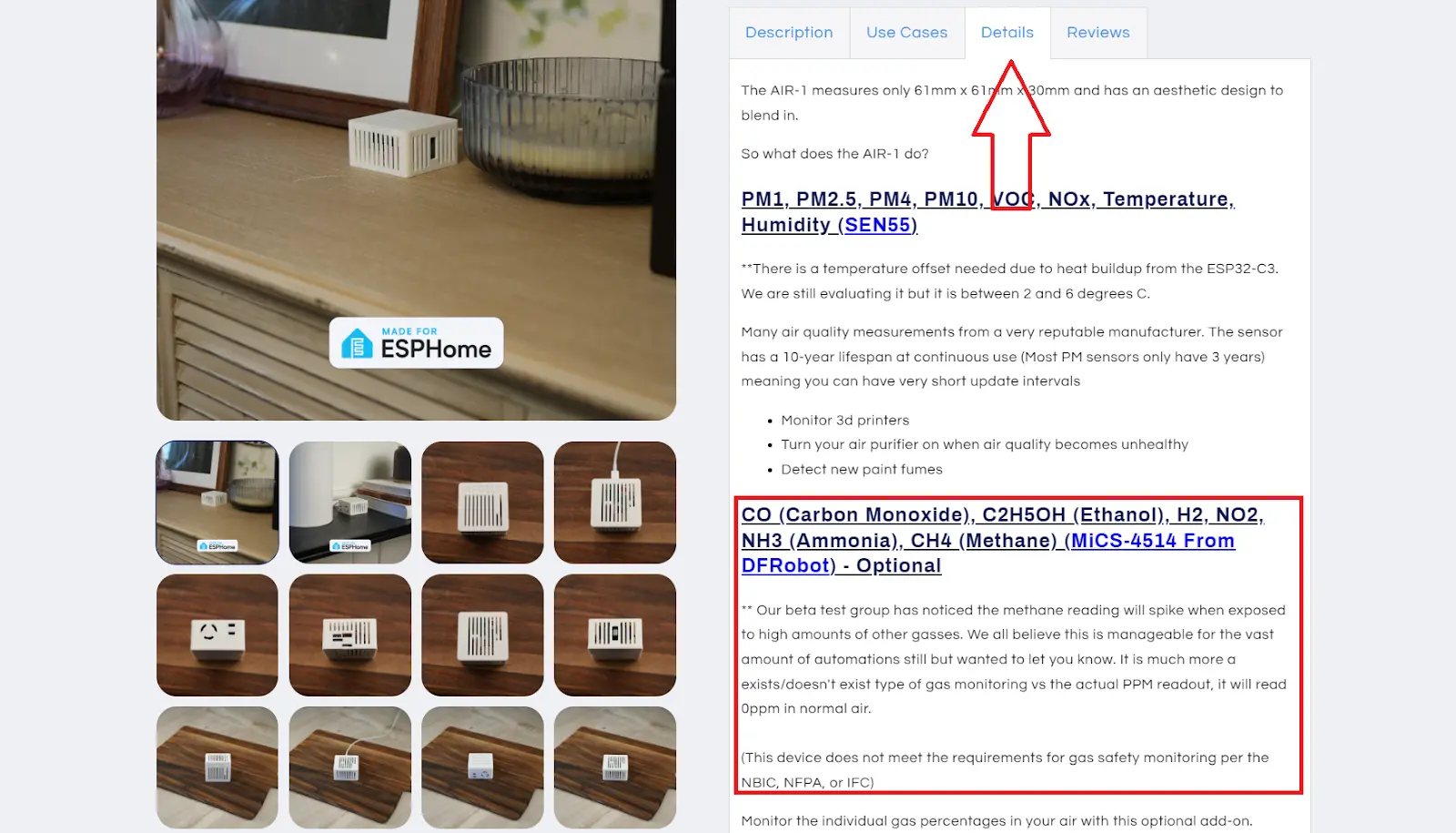
Apollo does mention some caveats about this sensor, but they’re only mentioned under the ‘details’ tab and aren’t immediately obvious. Furthermore, they don’t highlight the key issues with the sensor and instead highlight it as an exists/does not exist sensor (either there is a gas present or not - the ppm readings should not be relied upon), but even this is generous as we’ve seen the sensor can be very cross-sensitive, and an ammonia reading could mean ammonia, methane, ethanol, hydrogen sulfide, propane, or another gas altogether is present.
Apollo has also defended the decision to include this sensor, which has been requested by users and can be used for automation that doesn’t require high accuracy. For some customers, this sensor will have added value for this reason.
However, we think the warnings for this sensor need to be much clearer and more detailed - if the sensor is kept at all. The AIR-1 is a great device overall, but we believe this sensor has no place in the monitor because it’s inaccurate to the point of being entirely misleading.
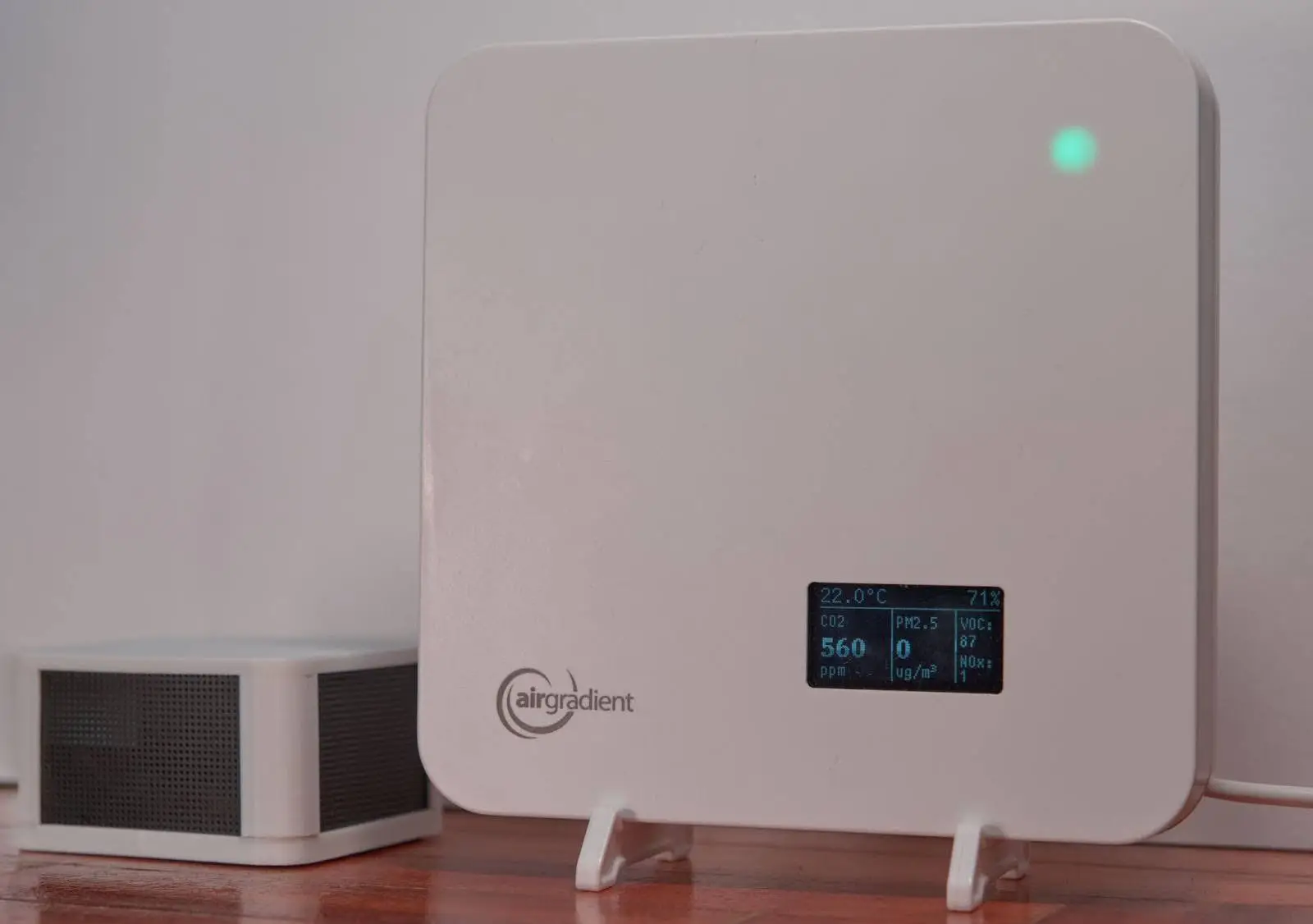
The design direction of the Apollo AIR-1 and AirGradient ONE differ greatly, and each design holds appeals for different audiences.
The Apollo AIR-1 is a tiny device that sits inside a 3D-printed and mesh case. Due to its extremely small size, the device is very easy to place out of sight. Since the monitor doesn’t feature a screen (you will need Home Assistant to view information from this monitor), being able to place this monitor out of the way is an advantage for many.
On the other hand, the AirGradient ONE is a much larger device that features a small OLED screen and a row of LEDs representing the current air quality. While the screen makes it best paired with the AirGradient dashboard or Home Assistant, it can also be used as a standalone device.
The design of the AirGradient device also means that sensors sensitive to interference by other components (such as the temperature sensor, which is influenced by heat generated by the other components) can be placed further away. While this can be overcome with offsets (as with the Apollo AIR-1), this is an important note to remember.
If you want an ultra-small indoor air quality monitor, it’s hard to find a device smaller than the Apollo AIR-1, and many people will appreciate its tiny size. On the other hand, if you want a device that displays measurements on a screen, the AirGradient ONE is more suited for you.
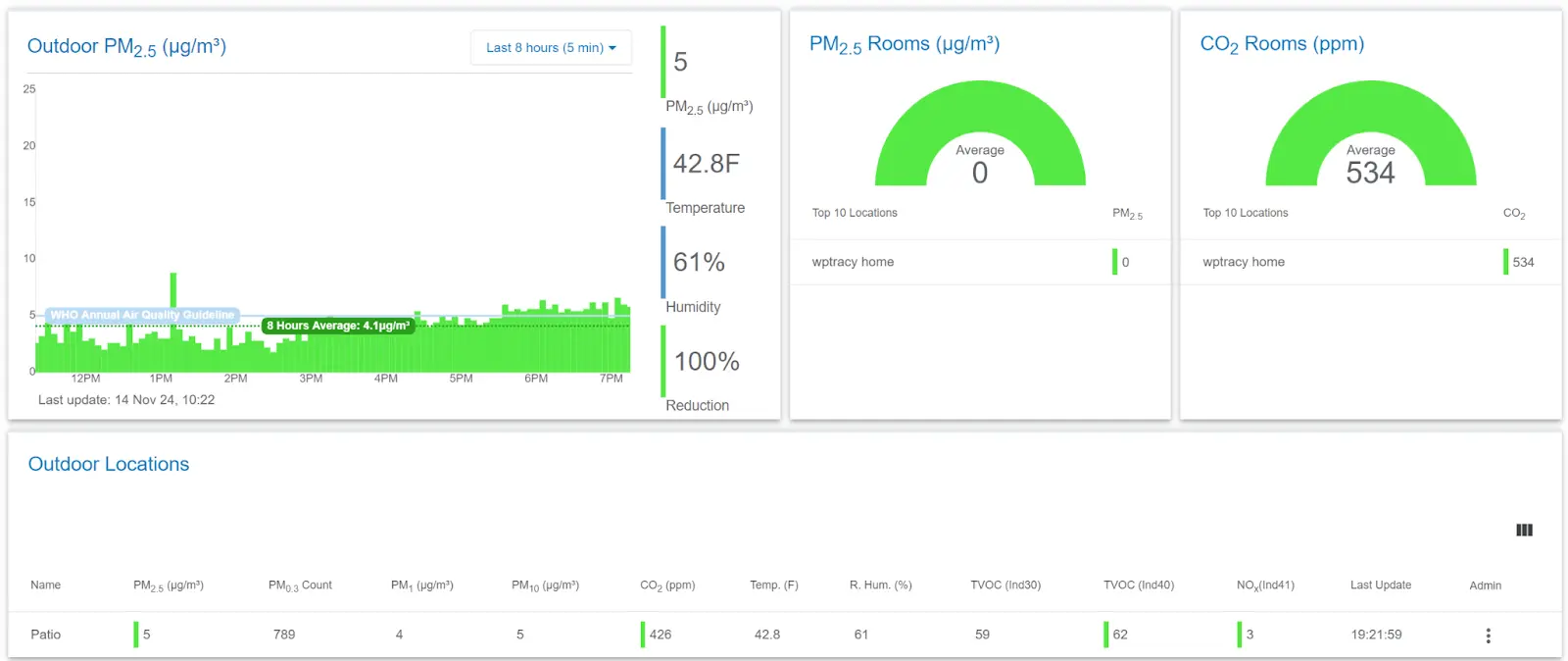
One area in which the AirGradient ONE and Apollo AIR-1 differ the most is their dashboards.
To begin with, both monitors use WiFi as their form of connectivity and support only 2.4GHz connections. To connect to a network, both use a captive web portal that you will need to access with a WiFi-enabled device such as a laptop or smartphone.
Both devices support Home Assistant if you have it running on your local network. Home Assistant is ideal for anyone running a smart home - especially if you already use the platform. It also has other strengths, such as being entirely local and ensuring your data remains private. However, the biggest difference between the two devices is that the Apollo AIR-1 requires Home Assistant to run, and there is no way to use the device without having it running on your network.
On the other hand, the AirGradient ONE can also be connected to the AirGradient dashboard either alone or alongside Home Assistant. This dashboard can be accessed through any browser, and since it’s a web app, it can also be saved on your smartphone’s home screen. This dashboard features graphs showing historical data and trends and live readings from all the device’s sensors. It also has some more advanced functionality, such as setting alarms and notifications. However, it’s not as customisable as Home Assistant.
The AirGradient ONE also supports some other smart home platforms, such as Homey, which is currently not supported on the Apollo AIR-1.
Both the Apollo team and the AirGradient team have shared values that can be seen in how we both approach our products. Here are a few key ways in which both monitors have significant advantages over the competition:
If any of these points is of particular importance to you, either of these devices will serve you well. We’re happy to see another company that shares our values in this space, and we are glad that customers have more options when it comes to air quality monitors that put the user first.
| Criteria | AirGradient ONE | Apollo AIR-1 |
|---|---|---|
| PM | Plantower PMS5003 | Sensirion SEN55 |
| CO2 | Senseair S8 | Sensirion SCD41 |
| VOC | Sensirion SGP40 | Sensirion SEN55 |
| NOx | Sensirion SGP40 | Sensirion SEN55 |
| Additional Gases | No | MiCS-4514 (not recommended) |
| Temperature/Relative Humidity | Sensirion SHT40 | Sensirion SEN55 |
| Connectivity | WiFi | WiFi (requires Home Assistant) |
| Platform | AirGradient Dashboard, Home Assistant, Homey | Home Assistant |
| Privacy & Local Operation | Offline & local support. (The user also owns all of their data when using the dashboard.) AirGradient Terms | Fully local operation through Home Assistant |
| RGB LED | Yes | No |
| Screen | Yes | No |
| Data Ownership | Unrestricted | Unrestricted |
| Open Source Hardware | Yes | Yes |
| Open Source Firmware | Yes | Yes |
| Price for Monitor | $195 (kit available for $138) | Starts at $90, up to $150 for the highest config. |
The AirGradient ONE and Apollo AIR-1 are often compared, and for good reason. In many ways, the two monitors are very similar and share many common strengths. However, there are also a few key differences between the devices.
AirGradient focuses much more on science, and has their own testing chamber with a reference device. All our fully assembled monitors go through a 12 h testing cycle. Furthermore, our monitors offer a native platform that runs without any additional hardware. While we do offer integration with Home Assistant (and other smart home platforms), this is not required to run the monitor.
On the other hand, Apollo focuses more on integration and requires Home Assistant to run. The device is also more affordable, but you will need a device on which to run Home Assistant. If you are looking at getting an Apollo AIR-1, we recommend the SEN55 + SCD41 configuration as opposed to the top-end configuration with the extra gas sensor.
Curious about upcoming webinars, company updates, and the latest air quality trends? Sign up for our weekly newsletter and get the inside scoop delivered straight to your inbox.
Join our Newsletter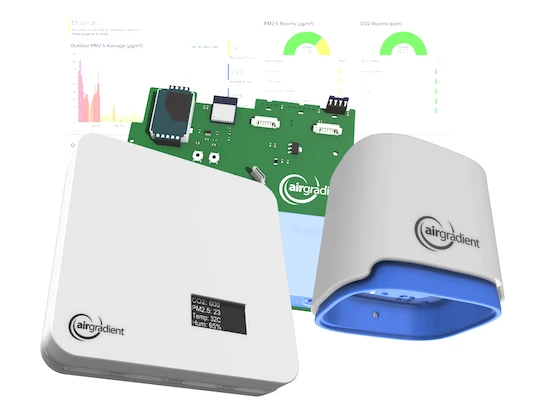
We design professional, accurate and long-lasting air quality monitors that are open-source and open-hardware so that you have full control on how you want to use the monitor.
Learn More